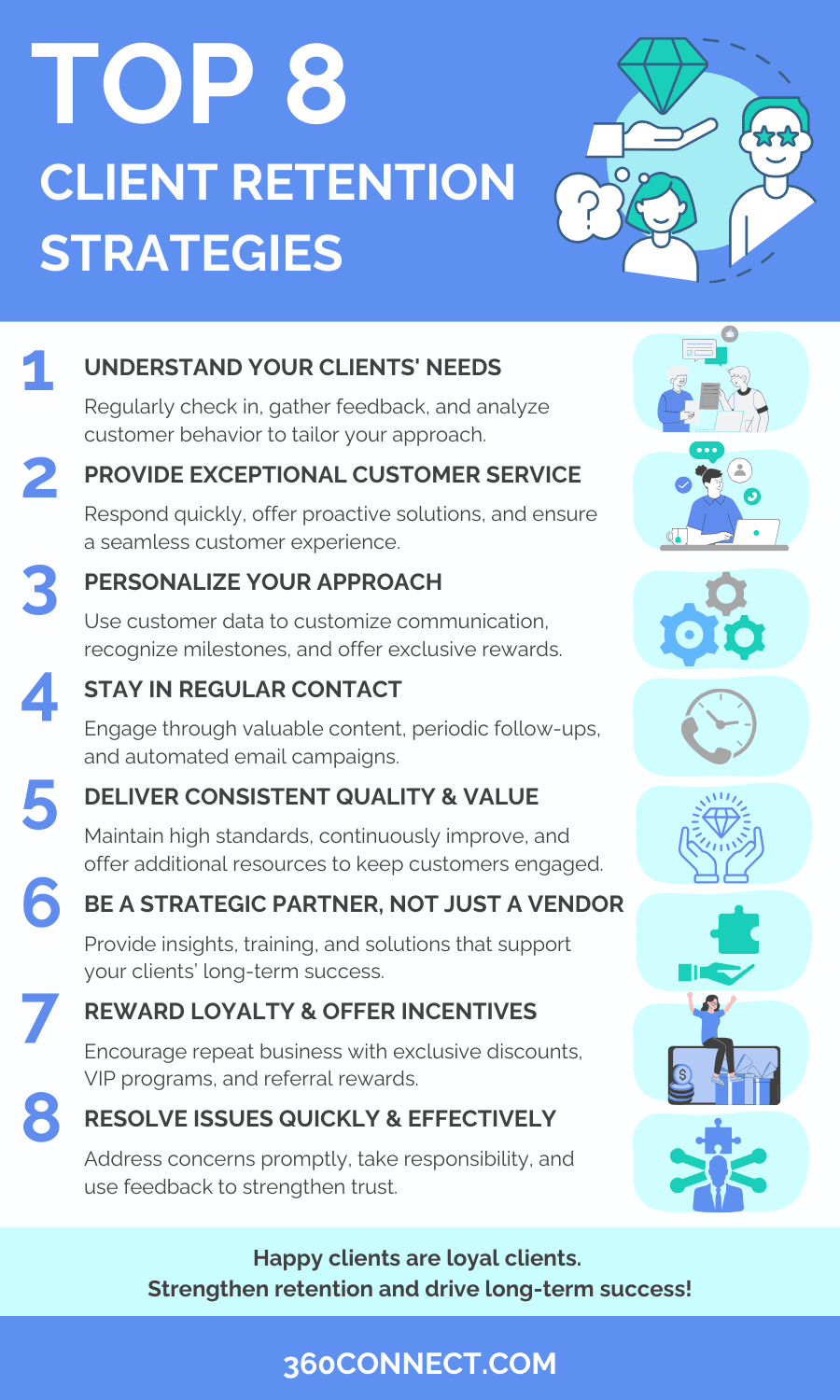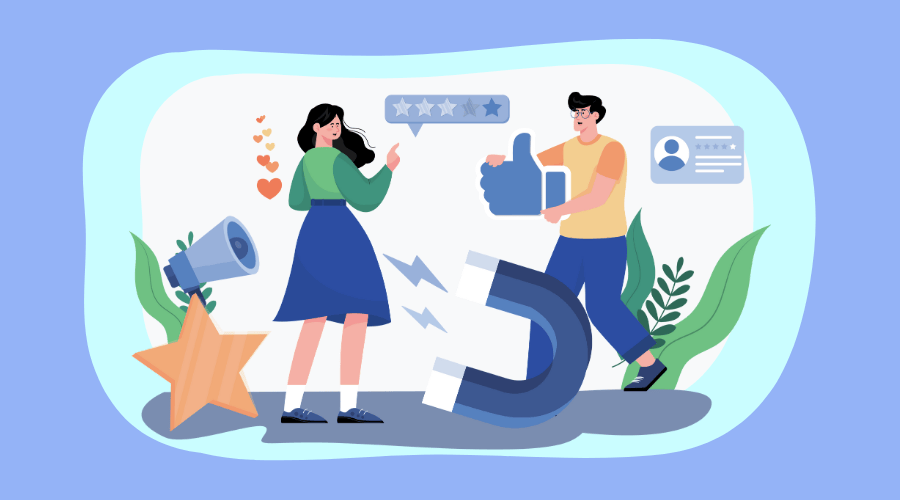The chances of selling to an existing customer are 60-70%. The possibility that you’re now even more interested in creating a winning client retention strategy? Nearly certain.
In B2B sales, customer retention isn’t just about keeping clients—it’s about maximizing their value over time. A well-crafted retention strategy helps you strengthen relationships, increase revenue, and build a sustainable business. If you’re spending most of your time chasing new leads while neglecting your existing customers, you’re leaving money on the table. Instead, focusing on retaining clients can lead to more repeat business, referrals, and long-term stability.
So, how can you create a client retention strategy that keeps your customers engaged and loyal? Let’s dive in.
What is Client Retention?
Client retention refers to a company’s ability to keep its customers over time. In simple terms, it means building strong, long-term relationships with buyers so they continue to do business with you instead of switching to a competitor.
Unlike client acquisition, which focuses on bringing in new customers, client retention ensures that the ones you’ve already worked hard to secure clients stick around and continue providing revenue.
A great client retention strategy isn’t just about keeping customers—it’s about keeping them happy, engaged, and coming back for more. It’s also about maximizing customer lifetime value (CLV), increasing referrals, and reducing churn, all of which contribute to a stronger and more predictable revenue stream.
Why is a Client Retention Strategy Important in B2B Sales?
New customers are 5x more expensive than existing customers. FIVE. TIMES. More Expensive. That means if you’re pouring all your energy into customer acquisition while neglecting retention, you’re not just working harder—you’re also spending more than necessary.
B2B sales thrive on long-term relationships. Unlike B2C, where transactions can be one-and-done, B2B customers expect ongoing value, trust, and consistency. When you invest in retention, you’re not only reducing churn but also building a steady revenue stream, creating brand advocates, and ensuring long-term success.
A client retention strategy leads to higher profitability, stronger brand loyalty, and a significant competitive edge. It ensures a steady revenue stream, allowing your business to plan and grow strategically. Investing in retention means building a foundation of satisfied clients who not only continue doing business with you but also become brand advocates, bringing in even more opportunities.
1. Higher Profitability
2. Stronger Trust and Loyalty
3. Competitive Advantage
4. Predictable Revenue Growth
How to Create a Winning Client Retention Strategy
To retain customers effectively, you need a structured plan that focuses on building stronger relationships, providing continuous value, and ensuring seamless customer experiences. Here’s how to craft a strategy that keeps your customers engaged and loyal.
Step 1: Identify Retention Gaps
Before improving client retention, you need to understand where you’re losing customers. Analyze churn rates, customer feedback, and engagement metrics to pinpoint problem areas. Look for patterns in lost clients—are they leaving after the first purchase, or is there a drop-off after a certain period? Understanding these gaps will help you tailor solutions that address real issues.
Step 2: Set Clear Retention Goals
Once you’ve identified gaps, set measurable goals for improvement. Whether it’s increasing customer lifetime value, reducing churn by a specific percentage, or improving customer satisfaction scores, having clear objectives will guide your strategy. Use key performance indicators (KPIs) to track your progress and make data-driven decisions.
Step 3: Develop a Customer Engagement Plan
Retention thrives on proactive engagement. Outline a plan to consistently interact with your customers through personalized emails, loyalty programs, regular check-ins, and exclusive offers. The goal is to maintain strong relationships and ensure customers continue to see value in your business.
Step 4: Implement Feedback Loops and Adjust
Customer needs evolve, and so should your retention strategy. Regularly collect feedback through surveys, reviews, and one-on-one conversations. Use this insight to refine your approach, address concerns quickly, and implement changes that align with customer expectations.
With a solid foundation in place, the next step is execution. Now, let’s explore the Top 8 Customer Retention Strategies that will help you turn your retention plan into actionable results.
Related: B2B Customer Retention Strategies Every Business Should Know
Top 8 Client Retention Strategies

1. Understand Your Clients’ Needs
The best and easiest tip for client retention? Understand your client.
A successful client retention strategy starts with actually knowing your customers’ goals, challenges, and expectations. Many businesses focus on selling their products or services without truly listening to what their clients need. Take the time to stop, listen, and understand what they’re really needing so you can be the one who provides it. In addition, taking a client-centric approach ensures that your offerings stay relevant and valuable over time.
One of the best ways to gain insight into client needs is through regular check-ins, surveys, and direct feedback. These conversations help you identify pain points, anticipate challenges, and adapt your offerings accordingly. Additionally, leveraging CRM data and analytics can provide valuable insights into buying patterns, service usage, and customer behavior.
- Conduct regular check-ins to assess satisfaction.
- Gather feedback through surveys and one-on-one conversations.
- Use analytics and CRM tools to track customer behavior and preferences.
2. Provide Exceptional Customer Service
In all honesty, there are likely other providers who do or offer something similar to your solution, so what makes clients keep coming back to you? The answer is simple, exceptional customer service.
Outstanding customer service is a key differentiator in B2B sales. Your clients expect fast responses, expert support, and proactive solutions. When businesses feel that their concerns are addressed quickly and efficiently, they’re more likely to continue working with you.
Speed and efficiency matter, but so does a personalized approach. Every client interaction is an opportunity to build rapport and demonstrate that their business is valued. Consider assigning dedicated account managers to long-term clients to ensure consistency and a high level of service.
- Ensure quick response times to inquiries and concerns.
- Offer proactive solutions to prevent potential issues.
- Train your team to prioritize client satisfaction at every stage of the buyer’s journey.
3. Personalize Your Approach
B2B buyers expect a unique experience, and a one-size-fits-all approach won’t cut it. When clients feel like just another number, they’re more likely to disengage or seek alternatives. Personalization fosters trust, strengthens relationships, and increases the likelihood of repeat business.
To personalize your approach, leverage CRM systems and customer data to tailor communications. A simple act like referencing a client’s previous purchase history or addressing a pain point they mentioned can go a long way. Offering customized solutions, pricing plans, or loyalty perks also reinforces your commitment to their success.
- Use customer data to tailor your communication and offers.
- Recognize important milestones like contract anniversaries or order history.
- Offer exclusive deals or loyalty rewards for long-term clients.
4. Stay in Regular Contact
A lack of communication can make clients feel neglected, leading them to seek engagement elsewhere. Regular, meaningful contact keeps your business top-of-mind and ensures clients feel valued even when they’re not actively making purchases. Consistent touchpoints also help identify potential issues before they escalate and create opportunities for upselling or cross-selling.
Effective contact strategies include email newsletters, personalized check-ins, and valuable industry insights. The goal isn’t to bombard clients but to offer relevant, helpful communication that keeps them engaged.
- Send valuable content like industry insights, case studies, and product updates.
- Schedule periodic follow-ups to check in and offer assistance.
- Use email automation and nurture campaigns to maintain consistent communication without being intrusive.
5. Deliver Consistent Quality and Value
One of the biggest reasons customers leave is a decline in product or service quality. Even the most loyal clients won’t stay if they feel your solutions no longer meet their needs. Consistently delivering high-quality service, reliable products, and ongoing value is key to long-term retention.
Beyond maintaining high standards, continuous improvement is essential. Whether it’s through product enhancements, better customer service, or additional educational resources, ensuring your customers always see value in your offerings will keep them engaged. Consider conducting periodic surveys to assess satisfaction and areas for improvement to enhance your client retention strategy.
- Ensure product/service quality remains high.
- Continuously innovate and improve your offerings.
- Provide added value through educational resources, webinars, or exclusive content.
6. Be a Strategic Partner, Not Just a Vendor
B2B buyers don’t just want suppliers—they want a trusted partner. A partner who will contribute to their growth and success. If your relationship is purely transactional, it’s easier for competitors to swoop in with lower prices or additional perks. However, by positioning yourself as an indispensable business resource, you increase client loyalty and retention.
This means offering proactive support, industry insights, and strategic recommendations that align with your client’s goals. Hosting exclusive webinars, providing market trend analysis, or offering tailored consulting services can set you apart from competitors and establish you as a valuable long-term partner.
- Offer insights that help their business succeed.
- Provide ongoing training and support for your products/services.
- Be a resource, not just a supplier.
7. Reward Loyalty and Offer Incentives
Loyal customers are the backbone of any successful business, yet many companies focus more on acquisition than appreciation. Recognizing and rewarding long-term clients fosters goodwill, increases engagement, and incentivizes repeat business.
Loyalty programs, tiered discounts, and referral rewards reinforce the value of staying with your company. Even small gestures, such as sending personalized thank-you notes or exclusive early access to new products, can make a big impact.
- Offer exclusive discounts or perks for long-term clients.
- Create a VIP program for your most valued customers.
- Reward referrals with incentives like service upgrades or discounts.
8. Resolve Issues Quickly and Effectively
Every business encounters problems, but how you handle them determines whether a customer stays or leaves. Clients understand that mistakes happen, but they expect swift and effective resolutions. Ignoring issues, delaying responses, or failing to take responsibility can quickly erode trust and lead to customer churn.
Having a clear and efficient issue-resolution process reassures clients that their concerns matter. Implementing a feedback loop also helps turn complaints into learning opportunities, improving overall service quality and preventing future issues.
- Acknowledge concerns promptly and provide solutions.
- Take responsibility for mistakes and make things right.
- Use negative feedback as an opportunity to improve and strengthen trust.
Final Thoughts on Client Retention Strategy
In B2B sales, a strong client retention strategy isn’t just an option—it’s a necessity. By focusing on building long-term relationships, providing continuous value, and ensuring a seamless customer experience, you can reduce churn, boost loyalty, and maximize revenue.
Remember: It’s not just about making the first sale. It’s about making every sale the first of many.
Need More Quality Leads?
Building strong client relationships is crucial, but having a steady stream of high-quality leads is just as important.
Join 360Connect’s Supplier Network and get matched with businesses actively searching for your products and services.

